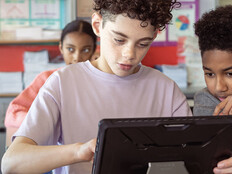Help Students Express Complex Feelings
For students who have a difficult time expressing emotions or feelings, you can use memes or colors to help them gain a better awareness and understanding. We recommend using engagement tools like Nearpod to help students share their feelings. You can do this by presenting them with a set of nine images with recognizable characters or critters that display distinct emotions. Search online for a “scale of feelings” meme, and if, for example, you pull up a Baby Yoda scale, you can ask students using a multiple-choice poll: “On a scale of Baby Yoda, how are you feeling today?” This will provide you with an immediate temperature check of your students’ emotional state.
To help students express more difficult emotions, you can also do a search for therapist Gloria Willcox’s colorful “feeling wheel” or psychologist Robert Plutchik’s interactive “wheel of emotions” and share with your students.
Online Tools Build Safe Communication in the Classroom
Think about a time when speaking up in a meeting didn’t feel safe, when ideas would be discounted or someone else would take credit. Students have these same concerns. Establishing psychological safety within our classrooms is vital to building those relationships and can help students make more responsible decisions.
We recommend teachers use Slido or a similar ed tech tool to post anonymous fun questions for open-ended responses, multiple-choice answers or a visual to create that safe classroom community.
Questions can be images, like the ever popular “one’s gotta go” game, where students must choose an item to remove. You can also post “would you rather” questions, which tend to spur lively debates.
When your students see that your classroom encourages curiosity and open-mindedness, they will feel comfortable speaking up or defending their responses in class, thus reinforcing responsible decision-making.
KEEP READING: Game-based learning prepares K–12 students for a digital future.
Know What Students Are Facing Before Starting Class
Just like fingerprints, every child is unique, with a specific set of experiences that will shape their responses to a new learning environment. Understanding a student’s individual state of mind is a crucial part of relationship-building.
For the past few years, Delaine has been using a daily one-question survey that asks, “What should Mrs. Johnson know today?” It’s a simple form that teachers can create that allows students to check in each day. For budding readers, you can use the drawing and audio functions in Seesaw for the same outcome.
These tools serve double duty, allowing Delaine to take attendance while getting a snapshot of what’s going on in the hearts and minds of her students that day, and specifically that hour. Some respond by sharing that they didn’t get much sleep or that they are hungry; some use it to share a joke or a concept they’re struggling with. Delaine can then adjust her lesson based on this feedback and address issues privately with individual students as needed.
We know these suggestions are a small part of a much bigger effort to help connect students’ hearts and minds. However, we recommend that educators try them and take it one step at a time. You can find these and our many other SEL and digital wellness resources for educators at heartmind.us.
UP NEXT: Software solutions keep mental health at the forefront.












